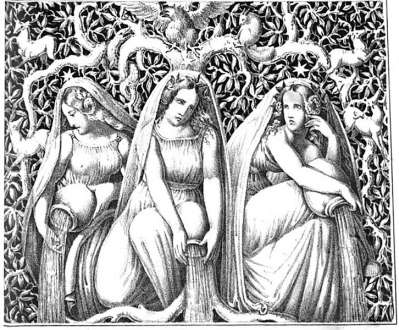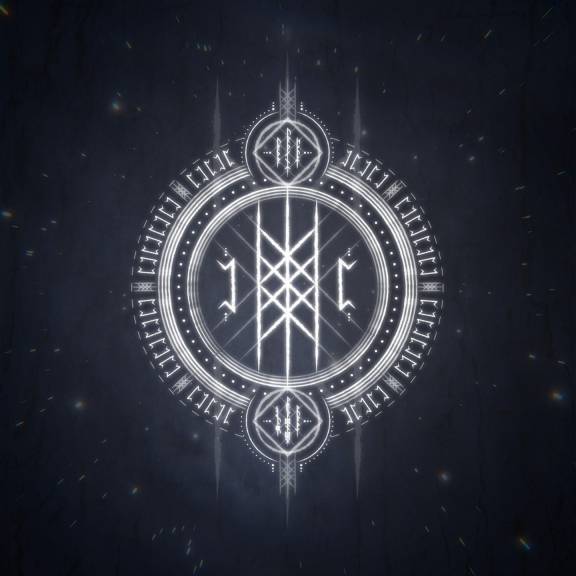The Vikings’ view on fate and how they believed their life and death were predestined has always fascinated me. In their society violence was never far away and your honor was much more important than your life. This is to me what the Web of Wyrd symbolizes and I will explore its origins and meaning in this post.
While the Web of Wyrd concept and its symbol is modern, it draws on these very ideas about predestined fate. At birth, your fate, later steering your life all the way to your death was decided by the Norns.
This obviously guided a lot of the Vikings’ approach to life, and possible death. Worth noting is that while their life and death was predestined, what happened after death was not necessarily so. If you lived an honorable life, showed bravery and died in battle, then after death you were on your way to Valhalla. This was in the realm of your control. Playing the cards fate dealt you the best way you could was the key.
In Viking warrior society however, this freedom to pursue their own final destiny seemingly only applied to men. Women, and children who died young, would seeming later end up on the road to Hel either way.
Fate predestined in the Web of Wyrd

In the old texts, reference is made to the three Norns either carving people’s fate into the roots of Yggdrasil or weaving it with golden threads. The three Norns who live by Urðarbrunnr (Well of Urd) at the foot of Yggdrasil are named, Urðr, Verðandi, and Skuld.
The meaning of their names is by some said to represent the past, present and future, respectively, but that is not a straightforward translation. However, what is certain is that the Old Norse Urðr can be translated as meaning Fate. Furthermore, her name has sometimes been translated to the Old English Wyrd, also meaning fate.
This has given rise to the most modern of Viking symbols called the Web of Wyrd, and it represents the concept of weaving the fate of men and gods alike. While this concept has roots that go to the core of the Vikings belief system regarding destiny and how fate was shaped, the symbol and name is not of the Viking Age.
However, while the name “Web of Wyrd” and the symbol might not be old, it works great as a visualization. Capturing the concept of predestined fate, woven together in a great web as the Vikings believed it.
Weaving the fates of men in the Eddas and Sagas
As mentioned already, the concept of fate being predestined and the imagery of one’s destiny being woven is decidedly Viking Age. There are several mentions of the Norns, but also the Valkyries, weaving men’s fate. I am including two interesting references below. One is from Norns weaving at a child’s birth, in the second Valkyries are weaving the fate of a battle.
Norns weave the fate of children at their birth
In the case of Helgi Hundingsbane, this is described in stanza two and three of Helgakvitha Hundingsbana I.
- It was night in the dwelling, | and Norns there came,
Who shaped the life | of the lofty one;
They bade him most famed | of fighters all
And best of princes | ever to be.
- Mightily wove they | the web of fate,
While Bralund’s towns | were trembling all;
And there the golden | threads they wove,
And in the moon’s hall | fast they made them.
When it comes to the Norns, the Eddas’ and sagas’ tell of them both carving the fates of man into the roots of Yggdrasil and of them weaving it as in the case of Helgi. There are in reality more than just the three Norns at the foot of Yggdrasil and this might be an important point. Possibly the three sisters at Urd’s well carve into Yggdrasil and other Norns who are not there, weave. This is purely speculation though as I haven’t found any sources for this.
Valkyries weaving the outcome of battles
In Njal’s saga, chapter 156 there is a full poem that does not appear anywhere else. Called “Darraðarljóð” (Song of the spear ) it is a particularly grisly recounting of how twelve Valkyries weave the outcome of a battle.
As the poem uses many kennings rather than names there are quite a few different translations/interpretations out there. I have worked off a few of those as I wrote a separate post on it with a full translation here.
In different translations, both the words “web” and “weird/wyrd” are used and this poem is a great example of the Web of Wyrd concept. There is little the warriors in the battle can do really, their fates are sealed as the Valkyries weave.
In the end the Valkyries tear the web apart, riding off with one piece each. This seems to be them heading into the battle, ensuring everything transpires as planned.
Here I am including the first verse of the bloody mayhem the Valkyries orchestrate:
The Woof of War
“Warp is stretched
For those falling in battle
The weft in the loom
is raining blood.
The fight is near
A gray weave
of men is made
Under maidens swift fingers,
Our warp bloodred
Our weft corpse blue”.
The Predestined Fate of the Gods

Just like the humans, the fate of the gods was also predestined and wholly outside of their control. Their fate is delivered to Odin in prophesied visions as by the Völva in the Völuspá and different sources. I have the feeling that the prophesied end in Ragnarök is almost as old as time itself.
The gods can no more outrun their fated destinies than any mere mortal can, but have to face it head on.
If it is the Norns, those ancient wise old women, who have also woven the web of the gods’ future is less certain. If not the Norns, then the end is seemingly just an inevitability derived from the very creation of the cosmos and the nine realms. Everything with a beginning must also have an end. It is all in the Web of Wyrd.
Featured Image Credit: Christopher Forster, CC0, via Wikimedia Commons

Thank you! I am just discovering my Nordic heritage, however I have always felt like I am a Viking. I think I love that this ‘web’ is “weird” – despite my possible misinterpretation, this resonates with me for many reasons, including that life itself is fantastical and incomprehensible. And, the weird people are the best people.
For sure, weird and colorful are the most interesting people!
Thank you for this information and opportunity to further my education about the web of Wyrd and Nordic history!!
Thanks for your appreciation Kyle!